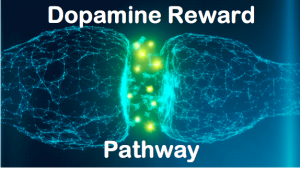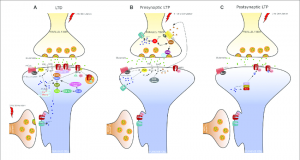
How do you picture addiction? Based off their personal experiences and knowledge people have an innate ability to paint their own image of addiction. For some it could be an alcoholic family member or friend who can’t seem to shake the habit. Personally when I think addiction baseball players who always seem to have some chewing tobacco in their bottom lip comes to mind. For others they think of tragedy, such as an overdose which has been running rampant in recent years. The prevalence and dire consequences of addiction has led to an abundance of research in recent years. While addiction looks different on the outside, some very distinct and fascinating neurochemical processes are taking place inside the brain manifesting in addictive behaviors that cause chaos for both addicts and the people who love them.
Neurochemical Mechanisms
In the brain addiction manifests itself one apparent pathway. Dopaminergic neurons (DA) stretching from the Ventral Tegmental Area of the Midbrain to the Nucleus accumbens (NAc=brain reward center) have been identified as a primary neural circuit in addiction. Every time you have a “feel good” feeling it is most likely there has just been a dump of dopamine into your nucleus accumbens. You got an A on a test? You get a shot of DA. You’re starving and you finally eat food after not having anything all day? Another shot of DA. Now let’s say you shoot up cocaine and have been for a while…well you just earned yourself a massive amount of dopamine into your NAc. You have just caused your body to release so much dopamine some very real, and a little scary, changes in your brain are about to take place.
Neurochemically speaking, there are several changes that are now going to take place. The synapses, or area where your brain communicates with other brain cells, can both increase and decrease in size in response to chronic drug use. Long term depression (LTD) occurs immediately in response to drug use as the synapse size decreases to the high concentration of chemical messengers. Over time this synapse increases (Long Term Potentiation) without the drug and can almost be thought of with the metaphor of synapse getting bigger and “craving” the drug.

Behavioral Learning
These neurochemical changes have behavioral manifestations. Your body becomes accustomed to taking drugs in certain situations, whether that be with people, places, or even in the presence of certain objects. As your body encounters these items a physiological response can take shape in the body. If you always do drugs in your car, every time you go to your car you might feel cravings, or maybe even start to feel your heart being faster. Your car has now become a conditioned stimulus that elicits a conditioned fear response that increases the likelihood that you will begin to take the drug.
The neurochemical and behavioral consequences of addiction are numerous, and one could spend a lifetime studying them. Perhaps the moral of the story is your brain changes in several ways with taking drugs, and the changes that take place are most likely not going to be pleasant.